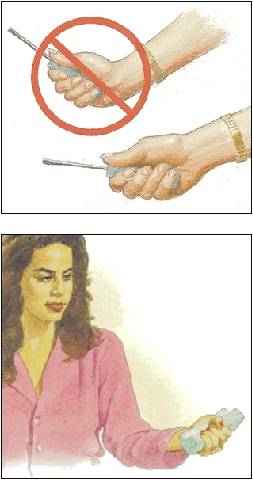Carpal Tunnel Syndrome Prevention Tips
Certain repetitive hand activities may put you at higher risk for developing carpal tunnel syndrome (CTS). By learning how to modify the way you use your hands, you may be able to reduce the risk. Keep the tips listed below in mind at home and on the job. And, be sure to follow your company's hand and wrist safety policies and procedures.

Keep your wrist in a neutral (straight) position when exercising.
Keep Your Wrist in Neutral
Avoid using your wrist in a bent (flexed), extended, or twisted position for long periods of time. Instead, try to maintain a neutral (straight) wrist position.
Watch Your Grip
Gripping, grasping, or lifting with the thumb and index finger can put stress on your wrist. When practical, use the whole hand and all the fingers to grasp an object.
Minimize Repetition
Even simple, light tasks may eventually cause injury. If possible, avoid repetitive movements or holding an object in the same way for extended periods of time.
Rest Your Hands
Periodically give your hands a break by letting them rest briefly. Or you may be able to alternate easy and hard tasks, switch hands, or rotate work activities.
Reduce Speed and Force
Reducing the speed with which you do a forceful, repetitive movement gives your wrist time to recover from the effort. Using power tools helps reduce the force.
Conditioning Exercises
Certain exercises strengthen the hand and arm muscles. They may help by reducing the need to compensate for these weak muscles with a poor wrist position.






